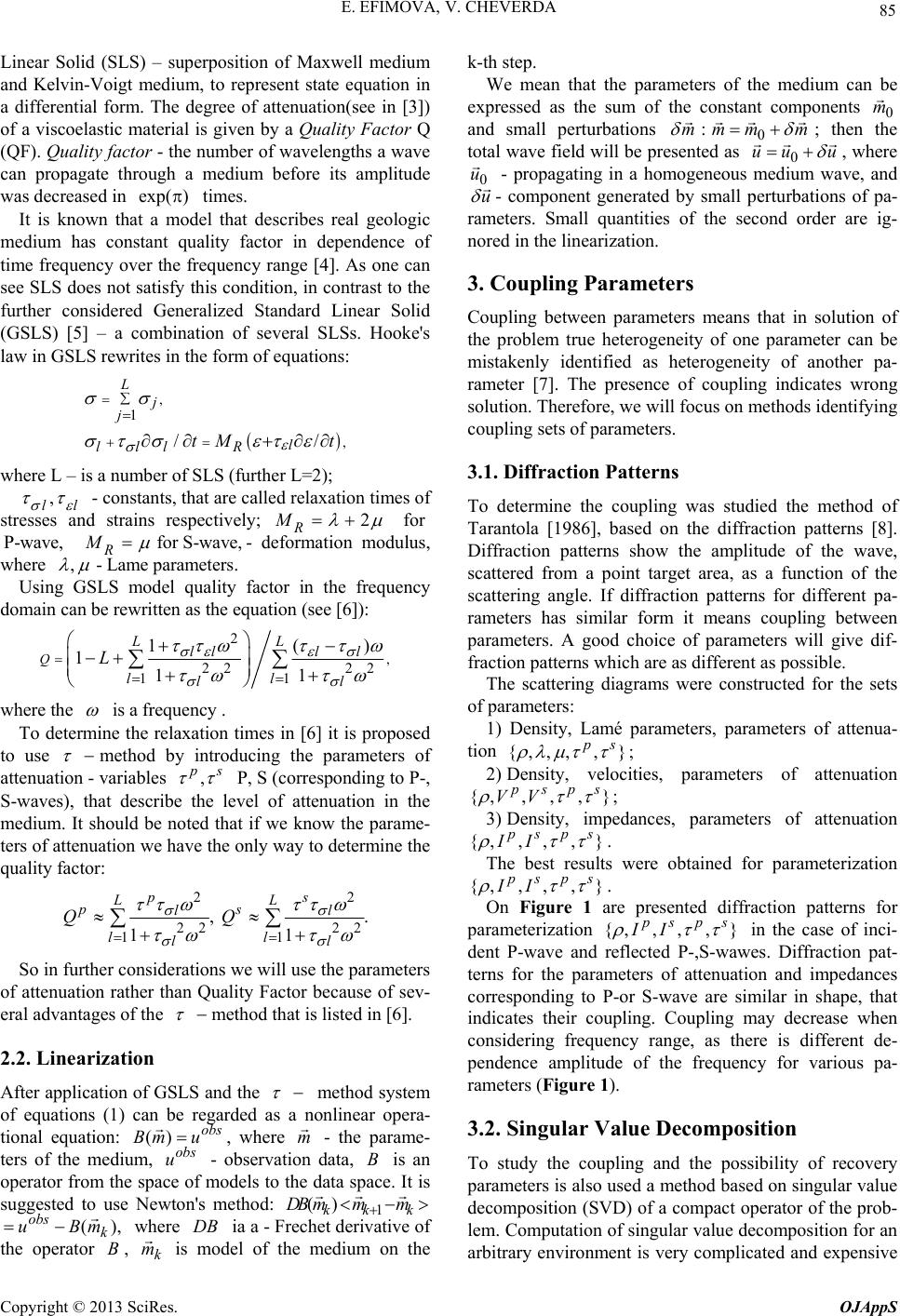
E. EFIMOVA, V. CHEVERDA 85
Linear Solid (SLS) – superposition of Maxwell medium
and Kelvin-Voigt medium, to represent state equation in
a differential form. The degree of attenuation(see in [3])
of a viscoelastic material is given by a Quality Factor Q
(QF). Quality factor - the number of wavelengths a wave
can propagate through a medium before its amplitude
was decreased in times.
exp( )
It is known that a model that describes real geologic
medium has constant quality factor in dependence of
time frequency over the frequency range [4]. As one can
see SLS does not satisfy this condition, in contrast to the
further considered Generalized Standard Linear Solid
(GSLS) [5] – a combination of several SLSs. Hooke's
law in GSLS rewrites in the form of equations:
,
,
1
//
Lj
j
lllR l
Mtt
where L – is a number of SLS (further L=2);
,
ll
- constants, that are called relaxation times of
stresses and strains respectively; 2
R
M
- deformation modulus,
where
for
P-wave, , for S-wave,
R
M
- Lame parameters .
Using GSLS model quality factor in the frequency
domain can be rewritten as the equation (see [6]):
,
2
22 2
11
2
1
111
(
QLL
ll
l
l
ll
l
L
)
l
where the
is a frequency .
To determine the relaxation times in [6] it is proposed
to use
method by introducing the parameters of
attenuation - variables ,
p
P, S (corresponding to P-,
S-waves), that describe the level of attenuation in the
medium. It should be noted that if we know the parame-
ters of attenuation we have the only way to determine the
quality factor:
2
22
1
2
12, .
11
ps
ll
LL
ps
ll
l
QQ
2
l
So in further considerations we will use the parameters
of attenuation rather than Quality Factor because of sev-
eral advantages of the
method that is listed in [6].
2.2. Linearization
After application of GSLS and the
m
(DB
method system
of equations (1) can be regarded as a nonlinear opera-
tional equation: , where - the parame-
ters of the medium, - observation data, is an
operator from the space of models to the data space. It is
suggested to use Newton's method:
() obs
Bm u
obs
uB
1kk
)k
m mm
where ia a - Frechet derivative of
the operator , is model of the medium on the
k-th step.
)(,
obs k
uBm
BDB
k
m
We mean that the parameters of the medium can be
expressed as the sum of the constant components 0
m
and small perturbations m
:0
mm m
uu ; then the
total wave field will be presented as 0u
, where
0
u
- propagating in a homogeneous medium wave, and
u
- component generated by small perturbations of pa-
rameters. Small quantities of the second order are ig-
nored in the linearization.
3. Coupling Parameters
Coupling between parameters means that in solution of
the problem true heterogeneity of one parameter can be
mistakenly identified as heterogeneity of another pa-
rameter [7]. The presence of coupling indicates wrong
solution. Therefore, we will focus on methods identifying
coupling sets of parameters.
3.1. Diffraction Patterns
To determine the coupling was studied the method of
Tarantola [1986], based on the diffraction patterns [8].
Diffraction patterns show the amplitude of the wave,
scattered from a point target area, as a function of the
scattering angle. If diffraction patterns for different pa-
rameters has similar form it means coupling between
parameters. A good choice of parameters will give dif-
fraction patterns which are as different as possible.
The scattering diagrams were constructed for the sets
of parameters:
1) Density, Lamé parameters, parameters of attenua-
tion ,,{,, }
s
;
2) Density, velocities, parameters of attenuation
{,, },,
sps
VV
;
3) Density, impedances, parameters of attenuation
{},,,,
sps
II
.
The best results were obtained for parameterization
{},,,,
sps
II
.
On Figure 1 are presented diffraction patterns for
parameterization {,,,, }
sps
II
in the case of inci-
dent P-wave and reflected P-,S-wawes. Diffraction pat-
terns for the parameters of attenuation and impedances
corresponding to P-or S-wave are similar in shape, that
indicates their coupling. Coupling may decrease when
considering frequency range, as there is different de-
pendence amplitude of the frequency for various pa-
rameters (Figure 1).
3.2. Singular Value Decomposition
To study the coupling and the possibility of recovery
parameters is also used a method based on singular value
decomposition (SVD) of a compact operator of the prob-
lem. Computation of singular value decomposition for an
arbitrary environment is very complicated and expensive
Copyright © 2013 SciRes. OJAppS